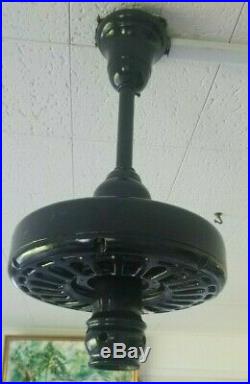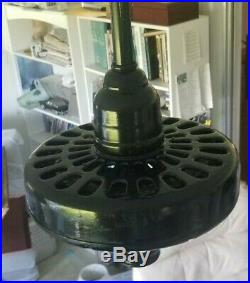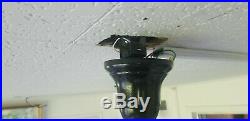











ANTIQUE 1920’S GENERAL ELECTRIC CEILING FAN-REBUILT, REFINISHED W/ REMOTE CONTROL & YOUTUBE VIDEO. Perfect choice for restoring a home over 80 to 120 years old with a fan that would have been originally installed. This GE was produced from 1917 to 1933 and would be the correct Ceiling Fan for a home built in that time frame. Some homes built even earlier did not get electricity and or fans till the 1910’s so it could have been the first fan installed in a home built even in the 1800’s. If your home was built in New York, you could take extra pride it was made in your home state. If you live in the ALBANY SCHENECTADY area even more so as this is where it was built. Check back later for a YOUTUBE link. As such we come across fans from 1906 to 1960 in need of minor restoration. The fan shown in white is just one of the many options we have for finishing. Color , we can do a professional finish in the colors: White, Black, Brown, Copper or Beige. Speed Control switch on the bottom. Length & color of the downrod bar and type of mounting system. Lighting options such as 4 & 6 globes and 4 stem classic lighting. All of our restored fans come with a 5-year guarantee to run smooth, quiet and trouble-free. But honestly, they are restored like new and the quality is such that they will easily run another 100 years. If you have high ceilings or large room you need a more powerful fan and this puts out about 20-30% more than most fans on the market yet draws only 100 watts on the medium speed which is more than enough for most applications. (88 watts low & 140 watts on high). Talking about a Classic Design. It is simply amazing you can own a very efficient appliance used on a daily basis that is over 100 years old. There is no reason this unit should ever fail for another 100 years. They were built to last with an oil bath bearing system that puts very little wear on the bearings. The motor windings have all been relaminated to prevent any shorting. The refinishing using top of the line enamel is second to none. You will not find a better example of “Made in America” build quality, that has better efficiency, power and longevity than a new fan. Fail Proof oil bath systems requires only 1oz of oil every 5 to 15 years depending on usage. The fan will give you a gracious warning when it starts making a little noise, nothing to fear however as you would have to continue running it for months before any minor damage would occur. As such, many people sell us their antique fan as they have neither the time or expertise to restore them. Restoring a hundred year old fan requires lot of time, special materials, experience and know how. It is a kind of art form you can spend 5 years learning all the details needed to do it correctly. Just a few of the many steps required. Thorough cleaning and inspection. Replace the input AC lead in wires. Relaminate motor coils & wiring. Resurface motor shaft, coils and armature. Refinish motor, brackets, downpipes, canopy and blades. Rewire speedcoil, lights & switches if applicable. THIS ALSO INCLUDES OUR EXCLUSIVE REMOTE CONTROL OR A STANDARD SPEED CONTROL. Like most all ceiling fans built from 1900 to 1970 this uses a “Shaded Pole” motor that DOES NOT need capacitors to start. By eliminating capacitors you improve reliability. These also have more torque than capacitor start motors. However, these “Shaded Pole” motors DO NOT work with any of the ceiling fan remote controls on the market. Our Remote control is THE ONLY ONE that work with “Shaded Pole” motors. We have developed one just for this market and it allows you 3 speeds. Medium & low speeds are individually adjustable. The Remote Control is mounted in a 3 gang outlet / switch box. Choice of mounting options include. Cut out of your existing wall switch area to make room for the 3 gang box. Cut out a hole in your ceiling near the fan and mount it there as a wall switch on your ceiling. If there is attic access you can go into the attic and place control box just above the fan without cutting any holes. Remember only the push button remote requires a battery, the control box does not. Cut out a hole in your attic / craw space next to your fan on the ceiling. Place unit in your attic / craw space then cover the hole with a special plate designed to cover drywall holes. Here is a link that sells a easy 7″ x 5″ cover plates for holes cut in your ceiling to fit 3 gang control box into. If using a swag style power cord the switch box can be placed near the wall outlet where it plugs in. Great for bedrooms where fan speed adjustment requires you to get out of bed to adjust a wall control or pull switch. Great for high ceilings where a long pull switch string is not desirable (assuming you still have a pull switch installed). If you happen to have an existing antique ceiling fan with a working speed switch, using this remote instead will preserve your original (and fragile) rotary speed control switch. You simply keep your original switch on high and let this remote do the speed changing. Track Page Views With. Auctiva’s FREE Counter. The item “VINTAGE 1920’S GENERAL ELECTRIC CEILING FAN W REMOTE ALBANY SCHENECTADY NEW YORK” is in sale since Thursday, May 30, 2019. This item is in the category “Antiques\Architectural & Garden\Chandeliers, Sconces & Lighting Fixtures”. The seller is “jj-do-it-products” and is located in Albany, New York. This item can be shipped to United States, Canada, United Kingdom, Denmark, Romania, Slovakia, Bulgaria, Czech republic, Finland, Hungary, Latvia, Lithuania, Malta, Estonia, Australia, Greece, Portugal, Cyprus, Slovenia, Japan, China, Sweden, South Korea, Indonesia, Taiwan, South africa, Thailand, Belgium, France, Hong Kong, Ireland, Netherlands, Poland, Spain, Italy, Germany, Austria, Bahamas, Israel, Mexico, New Zealand, Singapore, Switzerland, Norway, Saudi arabia, Ukraine, United arab emirates, Qatar, Kuwait, Bahrain, Croatia, Malaysia, Brazil, Colombia, Panama, Jamaica, Barbados, Bermuda, Bolivia, Egypt, Sri lanka, Luxembourg, Peru, Viet nam, Uruguay, Chile, Costa rica, Trinidad and tobago, Guatemala, Honduras.



